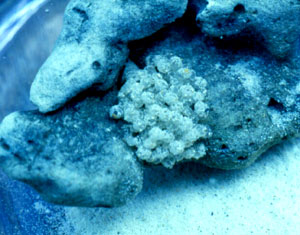






 |
 |

Squid Egg Mass
Caption:
Egg mass of the sepiolid squid Euprymna scolopes. Female squids lay clutches of 100 to 200 eggs on coral ruble and cover them with a layer of sand. After about 20 days, juvenile animals hatch and are immediately ready to become colonized by Vibrio fischeri cells, a marine bacteria that are present in the surrounding seawater. [See related images: Bioluminescent Sepiolid Squid, Bioluminescent Marine Bacterium Vibrio fischeri, and Ventral Dissection of Sepiolid Squid.]
This research is supported by a grant from the National Science Foundation's Directorate for Biological Sciences, Division of Integrative Biology and Neuroscience's Developmental Mechanisms Program.
The grant was awarded to Dr. Margaret McFall-Ngai, Ph.D., professor and principal investigator, for her studies on the relationship between the Hawaiian sepiolid squid Euprymna scolopes and its luminous bacterial partner Vibrio fischeri. Although all animals have beneficial associations with microbes, the association between Euprymna scolopes and Vibrio fischeri is the only experimental model available to biologists so far.

(Preview Only)

|
| Credit: |
Credit M. J. McFall-Ngai and E. G. Ruby, University of Hawaii |
| Year of Image: |
1991 |
|
Categories:
BIOLOGICAL SCIENCES / Integrative Biology
Formats Available:
Restrictions:
No additional restrictions--beyond NSF's general restrictions--have been placed on this image. For a list of general restrictions that apply to this and all images in the NSF Image Library, see the section "Conditions".
|